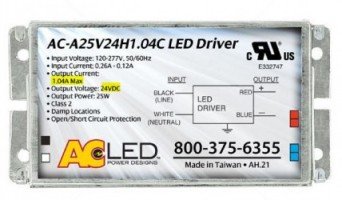Do I Need an LED Driver?
Updated 10/11/23 by 1000Bulbs Staff
Due to increasing energy regulations, most people are familiar by now with the long life span and energy-efficiency associated with an LED, or light-emitting diode, fixture.
However, many are not aware that these innovative light sources use specialized devices called LED drivers to operate. LED drivers (also known as LED power supplies) are similar to ballasts for fluorescent lamps or transformers for low-voltage bulbs; they provide LEDs with the correct power supply to function properly and perform at their best.
Below, we'll discuss when you need an LED driver, why you need an LED driver, and what type of driver you may need.
When is an LED Driver Needed?
Every LED light source requires a driver. The question isn't if an LED needs a driver, but whether you need to purchase one separately.
Some LED lights already include an integrated driver within the bulb. LED lights designed for household use (bulbs with E26 / E27 or GU24 / GU10 bases and that run on 120V) typically include the necessary internal drivers.
However, low-voltage LED light sources, such as some MR-bulbs (MR GU5.3s, MR8s, and MR11s) and LED strip lighting, as well as certain fixtures, panels, or outdoor-rated lights, usually require an external driver.
When an LED light that requires an external driver to operate correctly stops working before the end of its rated lifetime, it can usually be saved if the driver is replaced.
Why Do I Need to Use an LED Driver?
LED lighting is designed to run on low voltage (12-24V), direct current electricity. However, most places supply higher voltage (120-277V), alternating current electricity. An LED driver's main purpose is to rectify higher voltage, alternating current to low voltage, direct current. So, LED drivers regulate the voltage for LED lighting.
Additionally, LED drivers work to protect the LED system from voltage or current fluctuations. A change in voltage could cause a change in the current being supplied to the LEDs.
LED light output is proportional to its current supply, and LEDs are rated to operate within a certain current range (measured in amps). Too much or too little current can therefore cause light output to vary or degrade faster due to higher temperatures within the LED.
In sum, LED drivers serve two purposes: to convert higher voltage, alternating current to low voltage, direct current, and to keep the voltage or electrical current flowing through the circuit at its rated level.
What Type of LED Driver Do I Need?
There are two main types of external LED drivers, constant-current and constant-voltage LED drivers, as well as a third type of driver called an AC LED driver, which will also be discussed. Each type of driver is designed to operate LED lights with a different set of electrical requirements.
When replacing a driver, the old driver's input/output requirements must be matched as closely as possible. Key differences are detailed below.
Constant-Current LED Driver
Constant-current LED drivers power LED bulbs that require a fixed output current and a range of output voltages. There will be only one output current specified, labeled in amps or milliamps, along with a range of voltages that will vary depending on the load (total wattage) of the LED.
In the example to the right, the current output is 700mA, and the output voltage range is 4-13V DC (volts of direct current).
Constant-Voltage LED Driver
Constant-voltage drivers power LED bulbs that require a fixed output voltage with a maximum output current. In these LEDs, the current is already regulated, either by simple resistors or an internal constant-current driver, within the LED module.
These LEDs require one stable voltage, usually 12V DC or 24V DC. In the example to the left, the output voltage is 24V DC, and the output current is a maximum of 1.04A.
AC LED Drivers
AC LED drivers are actually no-minimum load transformers, meaning they could technically operate low-voltage halogen or incandescent bulbs as well.
LED lighting, however, cannot operate with conventional transformers because conventional transformers were not made to detect the low wattage of LEDs. In other words, LEDs have such a small electrical load that regular transformers do not register that they're wired to a bulb at all.
AC LED drivers are typically used with bulbs that already contain an internal driver that converts the current from AC to DC, so an AC LED driver's job is to register the low wattage of LEDs and step down the voltage to meet the bulb's lower voltage requirements, usually 12 or 24 volts.
AC LED drivers are typically used to power 12-24V AC input LED MR16 bulbs, but they can be used for any 12-24V AC input LED bulb. The LED bulb product data sheet must be carefully examined; if the LED bulb requires DC voltage input, it cannot be used with an AC LED driver.
Need to Know More About Choosing LED Drivers?
We've now discussed when, why, and what type of LED driver you need. Next time, we'll discuss the many other factors involved in choosing LED drivers. Among the many features and ratings to consider, you'll want to read all about dimmable external drivers, IP-ratings, UL class 1 or class 2 designations, energy-efficiency, and power factor.
Have any questions about whether you need a constant-current or constant-voltage driver or no external driver at all? Feel free to ask us in a comment or drop us a line on Facebook, Twitter, LinkedIn, or Pinterest!
For help from one of our knowledgeable US-based account managers, call 1-800-624-4488 or try our convenient “pop-up chat feature” at the bottom right corner of our 1000bulbs.com web pages.












